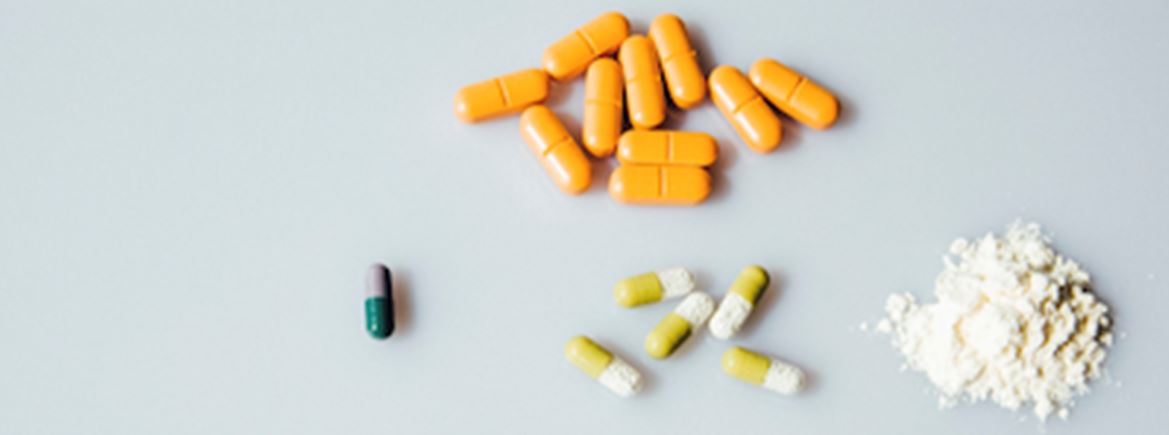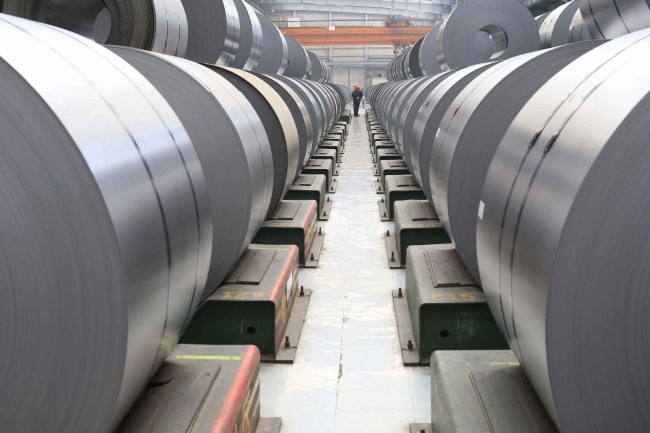API produced and exported by China account for 40% of the global provision. Short for Active Pharmaceutical Ingredient, API is a component for drug products. The API industry in China plays an important role in the global pharmaceutical ecosystem.
China’s position in the global API market
Pharmaceutical products have drastically varied features, some being patented and customized, while others generic and bulk manufactured. The production of pharmaceuticals, therefore, is heavily reliant on outsourcing and import and export. According to Results Healthcare analysis, the worldwide outsourced manufacturing market reached $71.5 billion in 2015 and is growing steadily. Since drug products are likely to be assembled where they are patented, API represents more than two thirds of the outsourced pharmaceutical market.
Compared to India or Europe, China is best at bulk manufacturing unbranded chemical API, according to sinolink securities.

Source: Sinolink securities, Segmentation of APIs. The API industry in China focuses on unpatented, bulk products.
China is world’s largest producer of pharmaceutical ingredients
Globally speaking, the chemical and generic APIs account for 70% of global API, while biotech APIs account for the remaining 30%.
China is the source of 40% of the global APIs, according to Optima insights. In addition, chemical APIs dominate theAPI industry in China. In 2017, the global API market size was at $156 billion, according to Sinolink securities. Chinese chemical API manufacturers had in total 500 billion RMB, which corresponds to approximately $74.6 billion. Thus, China takes 68.3% of chemical API market worldwide in terms of value.
Asia and Europe are the main export destinations of the API industry in China
According to China Chamber of Commerce for Import & Export of Medicine and Health products (CCCMHPIE in short): in 2019, APIs produced and exported by China reached 10.12 million tonnes (+9% year-on-year), worthy of $33.7 billion (+12% year-on-year).
The destinations of APIs produced and exported by China comprise of 189 countries and regions, mainly in Asia, Europe and North America. Over 2019, API export grew in Asia and Europe, but dropped in America, largely due to the Sino-US trade war. In fact, the volume of API produced and exported by China to the U.S. decreased 11% year-on-year. So much so that an increase in average export price of 11% did not compensate enough for the trade friction.
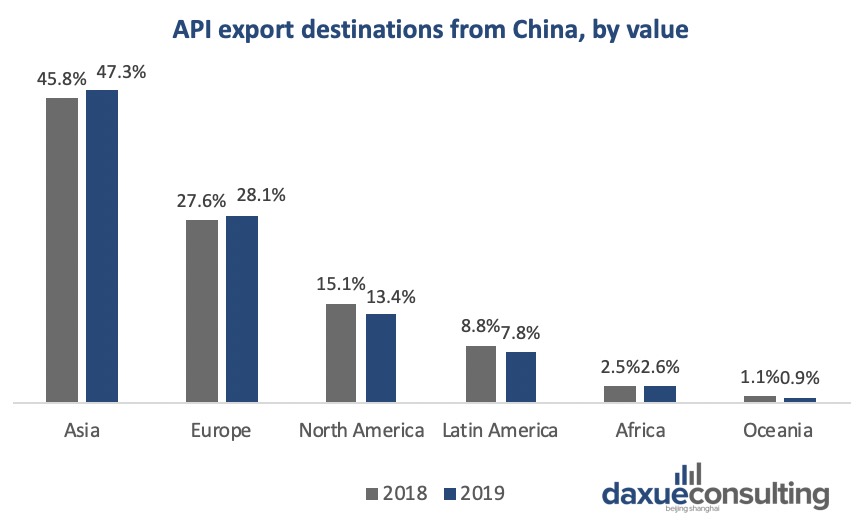
Data source: CCCMHPIE, Chinese API export destinations
To be more specific, the leading export destinations by country are India, the U.S., and Japan.
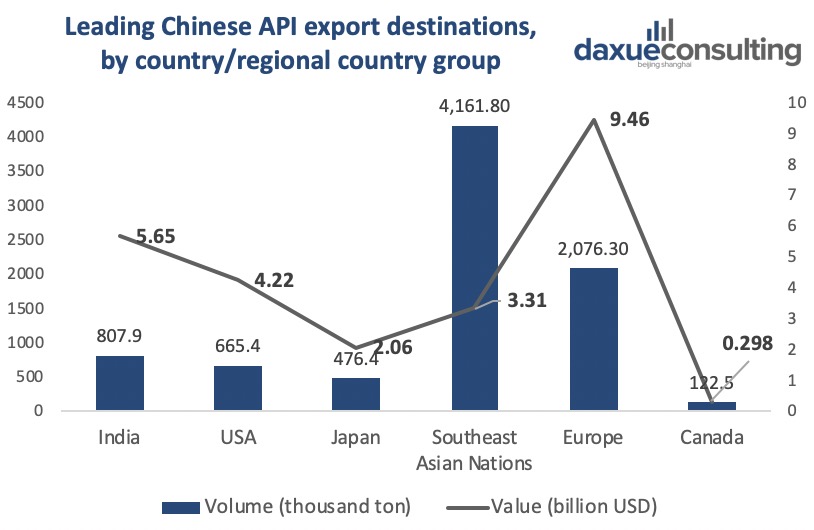
Data source: CCCMHPIE, leading Chinese API export destinations
APIs take up 81% of total value of Chinese pharmaceutical exports
The majority of Chinese pharmaceutical exports are APIs. In 2018, according to China Chamber of Commerce for Import & Export of Medicine and Health products: APIs exported from China accounted for 81% ($30 billion over $37 billion) of total value of exported Chinese pharmaceutical products. The rest of Chinese exports are pharmaceutical preparations, finished drug products (11%, $4.1 billion over $37 billion) and biochemical drugs (8%, $2.7 billion over $37 billion).
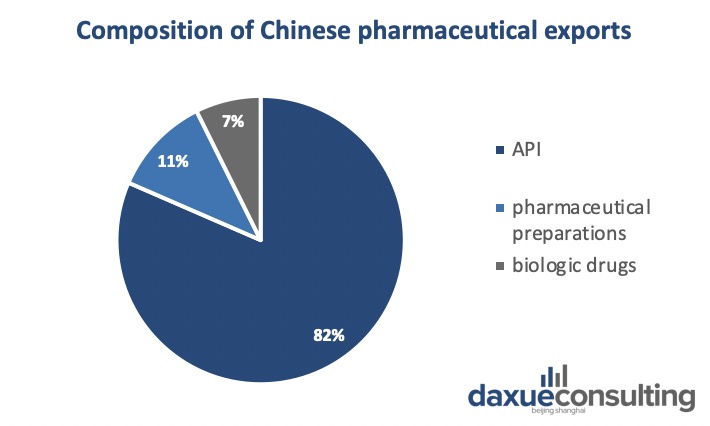
Data source: CCCMHPIE, composition of Chinese pharmaceutical exports
When it comes to API exporters in China, private companies take the lead. According to China Chamber of Commerce for Import & Export of Medicine and Health products, in 2019 there were in total 12,462 API manufacturers and exporters in China, an increase of 1,056 from 2018, almost all privately held.
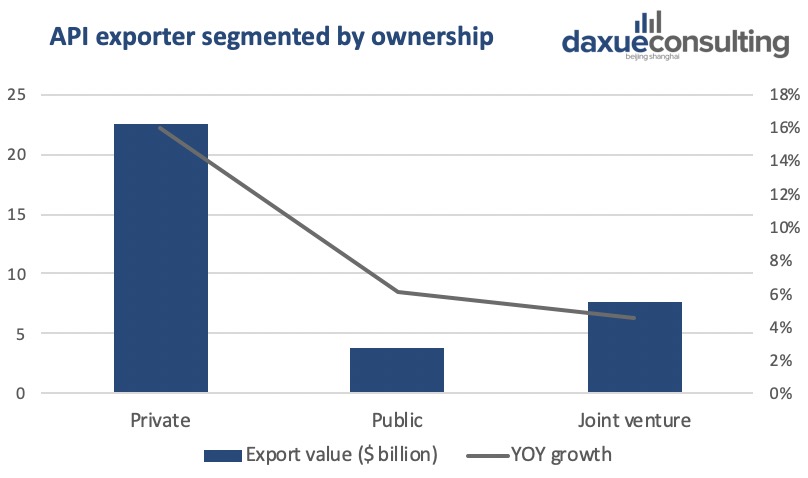
Data source: CCCMHPIE, Segmentation of Chinese API exporters by ownership
India is both competitor and customer of the API industry in China
The trade statistics suggest that nearly 75% to 80% of the APIs imported to the United States are from China and India. These two countries have well-established manufacturing facilities and an abundant talent pool serving the pharmaceutical industry.
India is a fierce competitor for API production
India is by far the world’s champion of drug master files (DMFs). What is a DMF? According to FDA, Drug master files (DMFs) are voluntary submissions to the import country authority, and contain confidential information about human drug products. APIs belongs to the Type II of DMFs, which is concerned with drug substance, material used in their preparation, or drug product.
While China holds 12% of DMFs from the U.S., India holds almost half of them. Being the largest holder of DMSs gives India the edge to export higher-value APIs, enlarging the industry’s attractiveness.
There are several reasons for India to outcompete China for API export in the last decade. Firstly, India normalized the API production with drug production, gaining bargaining power in the global market. Secondly, Indians generally speak better English than Chinese, which facilitated pharmaceutical trade with developed countries. Lastly, India adopts Common Law system, making the legal activities more fluid when dealing with western clients.
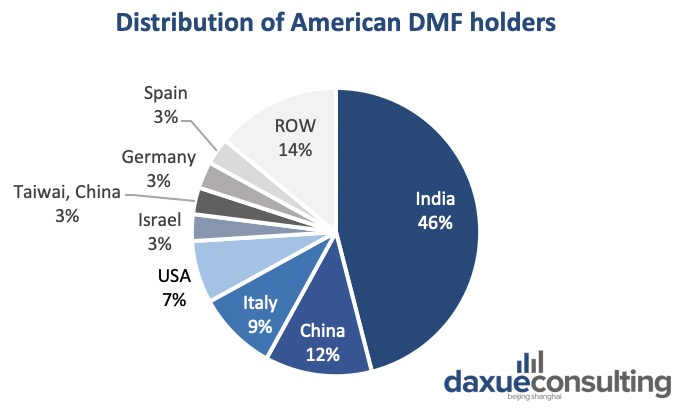
Data source: Thomson Reuters, Sinolink securities, Distribution of U.S. DMF holders
India relies heavily on China for API imports
India’s API imports are valued at $3.5 billion to per year. Of which 70%, worth $2.5 billion, are APIs produced and exported by China.
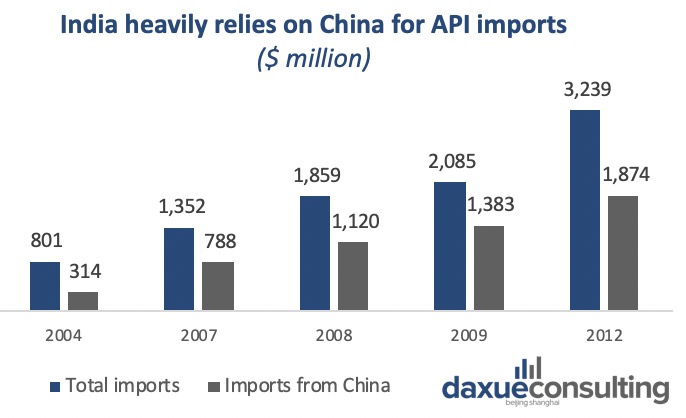
Data source: BCG analysis, Sinolink securities, Indian API imports from China
The Indian government has long advocated “API independence” and invested in API industry. Nevertheless, it is difficult to cut back dependence on China due to its climate characteristics. India mostly relies on China for APIs related with fermentation (发酵类产品), for which China represents 70% of global production. At around 10°C higher than China, fermentation is way more costly than in India.
Value and volume of China’s API exports tell two different stories
A quick example is to compare the API produced and exported by China in terms of both value and volume. Interestingly, even though the Association of Southeast Asian Nations takes 41.1% of volume of China-manufactured API, it only accounts for 9.8% of the value exported by China. Inversely, Europe and North America are the destination of 41.5% of the value of China-exported API, but in terms of volume, that only amounts to 28%.

Data source: CCCMHPIE, Chinese API export destination based on value
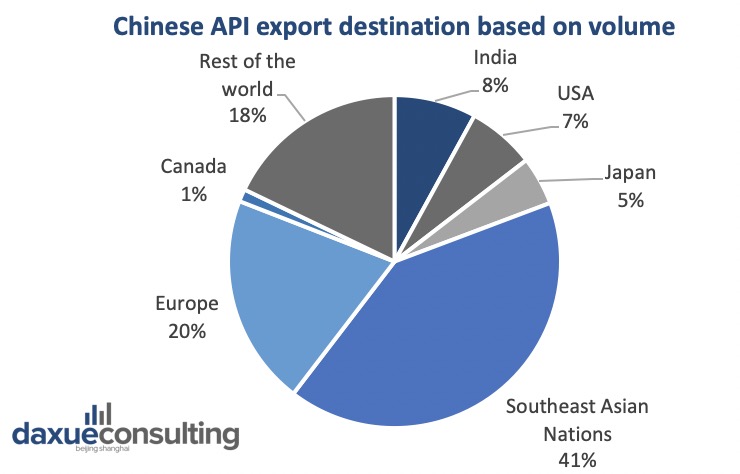
Data source: CCCMHPIE, Chinese API export destination based on volume
Sino-American API trade
There has been a question mark over whether or not China is the major supplier of APIs to the United States. Whereas the U.S. Food and Drug Administration data shows only 13% of its API is imported from China, other sources points to the opposite.
Both assertions are likely to be true and not necessarily contradictory, depending on whether we refer to volume or value, or the number of manufacturers.
On the one hand, China is indeed the world’s largest pharmaceutical producers and the biggest supplier to U.S. by volume. The observation that “China is the world’s largest producer of pharma ingredients and the world’s second largest pharma market” is confirmed by National Medical Products Administration in 2017. China in 2019 exported over $37 billion of pharmaceutical products, including APIs and DPs. In comparison, India’s total pharmaceutical exportation amounts to $20 billion in 2019/20.
On the other hand, USA seem to well diversify its import in terms of value. USA imported $78.9 billion pharmaceutical products in 2019, and China only accounts for $4.22 billion in terms of API value, a mere 5%. In addition, approximately 28% of manufacturing facilities making active pharmaceutical ingredients (APIs) for the U.S. market are based in the U.S. The remaining 72% of API manufacturers supplying the U.S. market are outside the U.S., this includes 26% in EU, 18% in India, and 13% in China.
Even though the number of China’s API manufacturers supplying the U.S. market is not great, the bulk API volume they manufacture and export can be high. Due to large-scale manufacturing capabilities, cost efficiency and adequate availability of commodity bulk drugs and intermediates.
China is positioning itself to capture a greater portion of the global industry
In summary, the massive API industry in China is an important global player of production and export. With the aging population and the growing pharmaceutical demand, China is positioning itself to capture a greater proportion of the global API manufacturing industry.
Author: Della Wang
Listen to 100 China entrepreneur stories on China Paradigms, the China business podcast
Listen to China Paradigm on Apple Podcast



